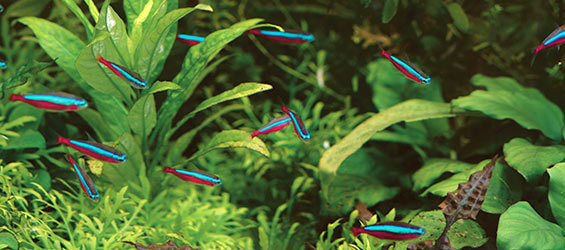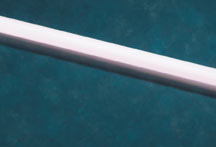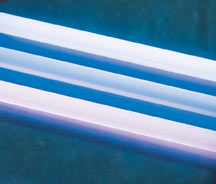
Because of their wide variety of sizes, wattages, and spectrum ranges, fluorescent systems are the most popular type of aquarium lighting system. Fluorescent light bulbs are simply gas-filled glass tubes. When electricity is passed through the tube, the gasses within the tube heat to the point where they give off light.
Fluorescent bulbs are coated inside with different blends of phosphors to achieve different spectrums of light. As the light passes through the coating, the phosphors produce colors based on their chemical makeup.
 Standard fluorescent bulbs offer the aquarist many benefits:
Standard fluorescent bulbs offer the aquarist many benefits:
- Wide Spectral Variety- Fluorescent bulbs are available in all different spectrum ranges. Different aquarium inhabitants require different light spectrums in order to thrive. With the possible exception of the deepest ocean corals, there is a fluorescent light with the proper spectral quality for every aquarium need.
- Low Initial Cost- Depending on the type of ballast used, the initial cost of standard fluorescent lighting systems is low to medium.
- Energy Efficient- Depending on the type of ballast used, the operating costs associated with burning a standard fluorescent lighting system is low.
- Minimal Heat Output- Standard fluorescent lights produce very little heat, thereby reducing the need for cooling fans or chillers.
In spite of these features, standard fluorescents possess a few limitations as well:
- Short Bulb Life- Regular use, along with the passage of time, degrades the gas and coating within the bulb, changing both the intensity and spectrum of the light produced by the bulb. Standard fluorescent bulbs typically last about 6 months before they significantly lose their intensity and spectral properties. If you use the more expensive electronic ballasts, you can increase the bulb life to approximately 12-14 months.
- Lower Intensity- Standard fluorescent tubes range from 20-40 watts. Depending on the needs of your aquarium inhabitants, you may need to install multiple fluorescent bulbs in order to achieve the required intensity.
 VHO Bulbs
VHO Bulbs
A different type of fluorescent light is the VHO (Very High Output) bulb. Similar in appearance to standard fluorescent tubes, VHO bulbs offer the aquarist more intensity for the same size. VHO bulbs require special ballasts and end caps. They cannot be used with standard fluorescent ballasts. VHO offer the following benefits and challenges to the aquarist:
- Greater Light Output- VHO lamps are about 3 times as intense as the same-sized standard fluorescent bulb. This means you can achieve the same intensity with fewer bulbs, thus taking up less space in your hood or fixture.
- Higher Kelvin Temperatures- The light produced by these bulbs is usually in the higher Kelvin range. This makes them great choices for many reef aquarium applications, but they may not be your best choice for freshwater planted aquariums unless supplemental lighting is supplied.
- Higher Energy Consumption- VHO lamps, while still an efficient light source, require more electricity to operate per bulb than standard fluorescents. However, you can achieve the same intensity with fewer bulbs.
- Longer Bulb Life- When used with electronic ballasts, VHO lamps should last 18 months or more without any significant decrease in intensity or spectral quality.
- Increased Heat Production- VHO bulbs produce significantly more heat than do standard fluorescents, which can significantly raise water temperature. Before installing VHO bulbs, make sure you provide a way for the excess heat to escape. This may include placing the lights 8-12 inches above the surface to provide enough ventilation, installing a ventilation fan in the lighting hood, or adding a water chiller to your aquarium setup.
For More Information:
Aquarium Lighting: Spectrum and Intensity
Aquarium Lighting: Systems and Bulbs
|